Boxing bouts and murderous mothers: tales from an historic Irving Boulevard home
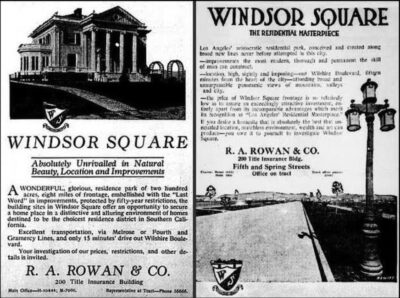
WINDSOR SQUARE development brochure.
Across the street from Getty House in Windsor Square is a home at 620 S. Irving Blvd. with a history and notoriety so rich that, in 1996, the home was designated City of Los Angeles Historic-Cultural Landmark No. 628.
“The Jack Doyle House,” as it was named for its first owner, was built in 1919 in the then-new Windsor Square development. Irving Hellman was an early investor and, in thanks, the street was named for him. Developer Robert A. Rowan planned Windsor Square as an upscale neighborhood. Those purchasing land parcels were bound by stipulations including the need to spend at least $11,000 to build a home, at a time when the average house in the United States cost just over $3,000 to construct. No expense was spared on “The Jack Doyle house,” with a final cost of $15,000 for the 4,400 square foot Mediterranean Revival home.
Jack Doyle
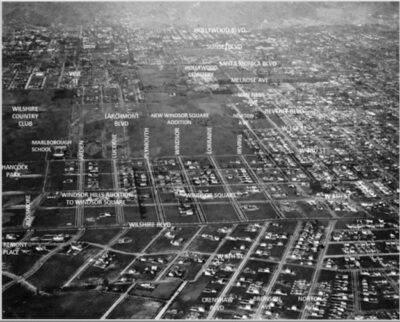
1918 AERIAL VIEW of Windsor Square and environs.
When Jack Doyle purchased the house, he had already transitioned to an entrepreneurial businessman from the Midwest railroad engineer he had been before heading to California to seek his fortune. Doyle connected with city of Vernon co-founder John Leonis, whose original plan was to build that city as a completely industrial area. Doyle thought it would be the perfect place to open a bar and boxing ring and did so in 1906-1907. The resulting arena and training center became the center of boxing in the Los Angeles area and famous nationally for luxurious training facilities, which included a pool and tennis courts. Overflow crowds crammed onto the outdoor benches to watch bouts between the greats, including Jack Dempsey.
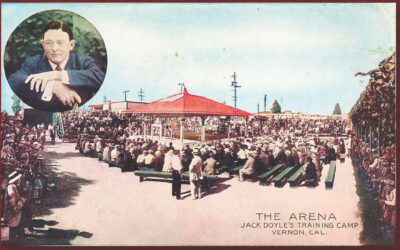
DOYLE’S ARENA and training center in Vernon, shown in postcard, with inset photo of Jack Doyle.
The Temperance movement had gotten a foothold in the country, and Los Angeles was dry, but Vernon allowed alcohol until Prohibition took effect in 1920, so Doyle’s bar, adjacent to the boxing ring, was equally popular. The so-called “longest bar in the world,” was 100 feet in length. 37 bartenders, each with his own cash register, tended to the thirsty patrons under the watchful eye of Mr. Doyle, who often greeted guests at the door or spied on them through holes drilled in the ceiling. Doyle was a teetotaler himself, and a sign above the bar reminded his customers, “If your children need shoes, don’t buy any booze.”
Adjacent to Doyle’s complex, a baseball diamond was home base for the Vernon Tigers, a club that Fatty Arbuckle owned for a few years. It is said that left fielder Jess Stovall would dash through the bar’s back door for a beer between innings. Prohibition caught up with Vernon eventually, and Doyle hosted a blow-out last call at his establishment on June 30, 1919. That night 60 bartenders served over 1,000 patrons.
Doyle’s booze era may have ended, but boxing was still a top draw, so in 1923 he razed his arena and built a modern, indoor 9,000-seat coliseum on the property. Fatty Arbuckle was a huge fan of boxing and an extra-wide seat was designed just for the portly actor. Many Hollywood luminaries flocked to the fights in Vernon, both to the original Arena and to Doyle’s Vernon Coliseum, including Charlie Chaplin, who sat ringside and delighted the crowds by acting out the action jab for jab.
In 1927 the baseball diamond caught fire, claiming Doyle’s boxing empire as a casualty. Doyle went on to invest in oil wells, and by his death in 1944 was a very rich man from striking oil on Signal Hill.
Leading man 1915
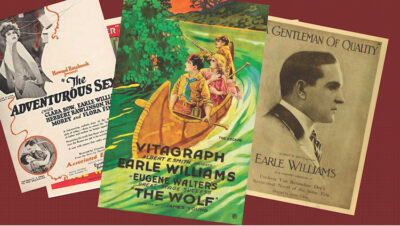
EARLE WILLIAMS silent film posters.
Previously, Doyle had enacted a property swap with silent film star Earle Williams, who moved into the Irving Boulevard home in 1925. Named the most popular leading man of 1915, and posthumously awarded a star on the Hollywood Walk of Fame, Williams made dozens of films, starring with such Hollywood elite as a young Rudolph Valentino in “A Rogue’s Romance” and with Clara Bow in “The Adventurous Sex.” In 1918 he had married Florine Walz, who was a credited writer on a few of his films, and they had a daughter, Joan. Their blissful life on Irving Boulevard was cut unexpectedly short when Williams died of double pneumonia in 1927 at the age of 47. His 29-year-old widow was left with an estate estimated to be worth $260,000 ($3,884,400 in today’s dollars).
The widow Williams made bad investments, including losing most of her money in an oil business scam run by her then-boyfriend Wallace Harvey, who left her destitute and with an out-of-wedlock child, Billy. Some news reports call her son Earle Jr., and the timing is such that she might have been in the early stages of pregnancy at the time of Williams death. It’s equally possible that she called him Earle Jr. to divert attention from her unfortunate dalliance with her scoundrel lover.
Life of crime
At any rate, after losing everything, Walz Williams entered a life of crime. She wrote bad checks, illegally attempted to take out a mortgage on her property, and after moving to the Bay Area to live with her mother Clarisse in a boarding house, stole $3,400 from her maid. She was already on probation for her past monetary indiscretions, and she convinced her maid to wait until the next day before calling the police, promising to raise the funds and repay her in the morning. Tragically, she was unable to write herself a happy Hollywood ending. That night Florine Walz Williams chloroformed her two children and she and her mother then did the same to themselves.
Ownership of the home on Irving reverted back to Jack Doyle, but it was sold twice: to real estate developer Paul Lewis Corrigan in 1933, and in 1938 to attorney Hubert F. Laugham, Sr., who owned it into the 1970s, when music impresario Paul Fishkin purchased it.
Music impresario
Fishkin started off as a music manager, notably for Todd Rundgren. Rundgren would take Fishkin to parties and bars, encouraging him to find a girlfriend, and even wrote one of his biggest hits for him, “We Gotta Get You a Woman.” Fishkin went on to date Stevie Nicks and created Modern Records with her and a third partner, Danny Goldberg. Although no longer Fishkin’s girlfriend, Ms. Nicks was one of the label’s biggest recording artists, and she is godmother to Fishkin’s daughter Molly.
Fishkin’s wife Janis made numerous improvements to the house on Irving Boulevard, including beautiful faux marbling in the entryway and gold leaf accents on the original moldings. The Fishkins also modernized the kitchen, expanding it into the former maid’s room, replanted the garden and added vegetable beds.
The Landays
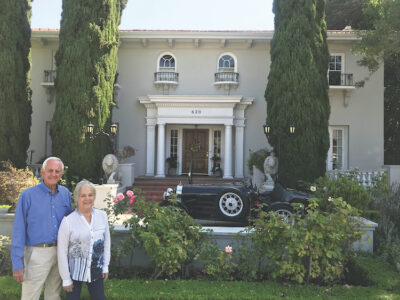
THE JACK DOYLE HOUSE: Current owners Peter and Suz Landay with their (replica) Bugatti in the driveway.
Suz and Peter Landay, the sixth and present owners of the landmark home, made some improvements of their own, most notably expanding the backyard loggia and installing lower-than-usual cabinets for easier access. The Fishkins had installed a large greenhouse window over the sink, and the Landays turned that into a real garden with greenery planted directly in the soil-lined base and butterflies metamorphosing from pupae on the growing leaves. Another novel feature is the built-in stepstool. Tucked into a mere inch-and-a-half of linear space, one can pull out a flat wooden panel which unfolds with the flick of a finger into a practical stool. The Landays also upgraded the expansive and exquisite garden, which has twice been featured on the Windsor Square-Hancock Park Historical Society Garden Tour.
In September over Zoom, the Landays shared their home’s features and history with nearly 80 Ebell of Los Angeles members and invited guests. “The Jack Doyle House” is just one of many area homes with amazing stories to tell.
Category: Real Estate
